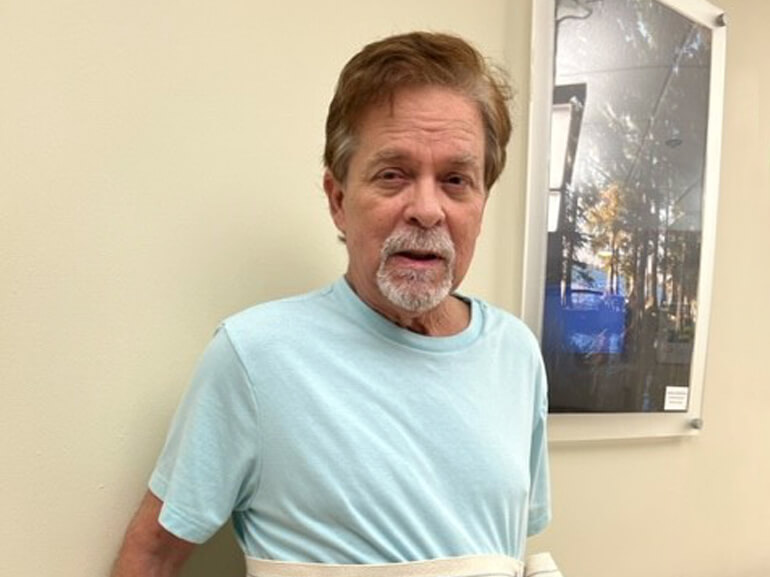Robert's story

As a supervisor for a bakery production company, Robert Rice, 67, traveled extensively around the country. A native of St. Louis, Robert lived alone and worked nights. One Sunday morning, he awoke feeling dizzy and with strange sensations in his right arm. As his dizziness worsened, Robert’s balance was affected to the point where he was crawling around his home on his hands and knees.
The next day, Robert called his doctor, who urged him to go to the local emergency room immediately. Unable to drive himself, Robert’s neighbor rushed him to SSM Health St. Clare Hospital, where he had numerous tests, including a CAT scan, MRI, x-rays, blood work and a swallowing study. After reviewing his results, physicians determined that Robert had suffered a rare cerebellar stroke, which accounts for less than 10 percent of all strokes.
Located in the lower back portion of the brain, the cerebellum’s function is to control movement and maintain balance. A cerebellar stroke occurs when a blood vessel is blocked or bleeding, causing an interruption to a portion of the brain. Robert’s stroke left him unable to swallow, requiring him to receive all nutrition via a feeding tube. His loss of balance meant that he was unable to walk. Robert was also experiencing double vision and struggling to speak. When his physicians recommended inpatient rehabilitation as the next step in his recovery, Robert was all in.
Upon arrival at SSM Health Rehabilitation Hospital – Bridgeton, Robert required assistance for almost every task. With a goal of returning home and “getting back to normal,” Robert’s physician-led rehabilitation team devised a care plan to help Robert regain as much function and independence as possible.
Physical therapists initially focused Robert’s therapy sessions on practicing transfers and improving his standing balance. As he improved, his therapists tested him more. “While there were challenges with just about every activity we performed, he never once refused a therapy idea,” said Robert’s physical therapist. Because Robert lives in a split-level home, he needed to be able to go up and down stairs. His therapists guided him on how to transfer from his wheelchair to the floor – so that he could go down stairs on his bottom.
As Robert’s balance improved, therapists utilized the innovative Lokomat, a robot-assisted gait-training device where patients are supported in a harness above a treadmill while the robotic device moves their legs through a "normal" gait cycle. During his first session in the Lokomat, Robert walked 700 feet in eight minutes, requiring multiple breaks due to lack of endurance.
Occupational therapists concentrated on helping Robert learn new ways to perform his self-care tasks, including dressing, bathing and using the bathroom. Therapists introduced adaptive equipment including transfer poles, which are floor-to-ceiling grab bars that provided support for sitting, standing or transferring to his wheelchair. Because Robert’s double vision was affecting his ability to perform tasks of daily living, he met with a neuro-optometrist and was soon using the Bioness Integrated Therapy System (BITS). BITS is an interactive touch-screen therapy device that helps improve hand-eye coordination, reaction time, depth perception and working memory. By playing engaging, interactive games and taking assessments, patients are able to improve their brain function and coordination. Using BITS helped Robert’s vision improve significantly, which helped his progress in both physical and occupational therapy.
In speech therapy, Robert’s team targeted on improving Robert’s ability to swallow, as he was “very motivated” to resume eating instead of relying on a feeding tube, according to his therapists. In his sessions, therapists guided Robert in using the Synchrony system, where electrodes attached to a patient’s throat detect electrical activity in muscles. The system provides real-time biofeedback about the effort and strength of the swallowing exercises with the goal of strengthening the throat and jaw to improve functional chewing, swallowing and speech. Robert also used the VitalStim, which uses electrical stimulation on the muscles responsible for swallowing. His speech therapists conducted regular swallowing assessments, which showed improvement each time.
A major turning point came for Robert during his last week in rehabilitation when he was able to walk nearly 200 feet with a wheeled walker and minimal assistance. “Robert had high expectations for himself and I really believe that is what helped him progress,” his physical therapist noted.
In preparation for his return home, Robert’s therapy team conducted a home evaluation with his family. During the evaluation, therapists made recommendations about ramp positioning, placement of grab bars in the bathroom and safe kitchen and bathroom set up, as well as specialized equipment recommendations to help Robert navigate around his home.
After 28 days at SSM Health Rehabilitation Hospital – Bridgeton, Robert’s vision and ability to walk and transfer had improved, allowing him more independence in his personal care. He had become skilled at getting down from his wheelchair so that he could “bump down” the stairs independently. Robert plans to continue his rehabilitation journey at the SSM Health Kirkwood Day Institute, where he will continue to build upon his improvements in swallowing, speech, balance and mobility.
Reflecting on his experience, Robert offered hard-earned insights for others facing similar challenges: "Be positive, work hard, and never take things for granted." One of his therapists offered high praise for Robert, stating, “I think I’ve learned just as much from him as he has from us. It has been a great privilege to work with him and I can’t express how excited I am with his progress.”